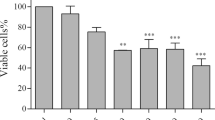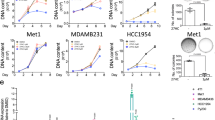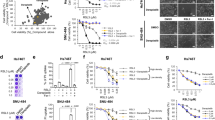Abstract
The natural phytoalexin resveratrol (3, 5, 4′-trihydroxystilbene) exhibits both chemopreventive and antitumor activities through a variety of mechanisms. We have shown previously that resveratrol-induced apoptosis of a human colon cancer cell line involved the redistribution of CD95 (Fas/Apo-1) into lipid rafts. Here, we show that, in colon cancer cells that resist to resveratrol-induced apoptosis, the polyphenol also induces a redistribution of death receptors into lipid rafts. This effect sensitizes these tumor cells to death receptor-mediated apoptosis. In resveratrol-treated cells, tumor necrosis factor (TNF), anti-CD95 antibodies and TNF-related apoptosis-inducing ligand (TRAIL) activate a caspase-dependent death pathway that escapes Bcl-2-mediated inhibition. Resveratrol does not enhance the number of death receptors at the surface of tumor cells but induces their redistribution into lipid rafts and facilitates the caspase cascade activation in response to death receptor stimulation. The cholesterol sequestering agent nystatin prevents resveratrol-induced death receptor redistribution and cell sensitization to death receptor stimulation. Thus, whatever its ability to induce apoptosis in a tumor cell, resveratrol induces redistribution of death receptors into lipid rafts. This redistribution sensitizes the cells to death receptor stimulation. Such a sensitizing effect may be of therapeutic interest if TRAIL agonists are introduced in clinics.
This is a preview of subscription content, access via your institution
Access options
Subscribe to this journal
Receive 50 print issues and online access
$259.00 per year
only $5.18 per issue
Buy this article
- Purchase on Springer Link
- Instant access to full article PDF
Prices may be subject to local taxes which are calculated during checkout








Similar content being viewed by others
References
Algeciras-Schimnich A, Shen L, Barnhart BC, Murmann AE, Burkhardt JK and Peter ME . (2002). Mol. Cell. Biol., 22, 207–220.
Bernhard D, Tinhofer I, Tonko M, Hubl H, Ausserlechner MJ, Greil R, Kofler R and Csordas A . (2000). Cell Death Differ., 7, 834–842.
Boatright KM, Renatus M, Scott FL, Sperandio S, Shin H, Pedersen IM, Ricci JE, Edris WA, Sutherlin DP, Green DR and Salvesen GS . (2003). Mol. Cell, 11, 529–541.
Brakenhielm E, Cao R and Cao Y . (2001). FASEB J., 15, 1798–1800.
Chan SW, Hegyi L, Scott S, Cary NR, Weissberg PL and Bennett MR . (2000). Circ. Res., 86, 1038–1046.
Clement MV, Hirpara JL, Chawdhury SH and Pervaiz S . (1998). Blood, 92, 996–1002.
Delmas D, Rebe C, Lacour S, Filomenko R, Athias A, Gambert P, Cherkaoui-Malki M, Jannin B, Dubrez-Daloz L, Latruffe N and Solary E . (2003). J. Biol. Chem., 278, 41482–41490.
Donepudi M, Mac Sweeney A, Briand C and Grutter MG . (2003). Mol. Cell, 11, 543–549.
Dorrie J, Gerauer H, Wachter Y and Zunino SJ . (2001). Cancer Res., 61, 4731–4739.
Fulda S and Debatin KM . (2004). Cancer Res., 64, 337–346.
Garofalo T, Lenti L, Longo A, Misasi R, Mattei V, Pontieri GM, Pavan A and Sorice M . (2003). J. Biol. Chem., 277, 11233–11238.
Holler N, Tardivel A, Kovacsovics-Bankowski M, Hertig S, Gaide O, Martinon F, Tinel A, Deperthes D, Calderara S, Schulthess T, Engel J, Schneider P and Tschopp J . (2003). Mol. Cell. Biol., 23, 1428–1440.
Huang C, Ma WY, Goranson A and Dong Z . (1999). Carcinogenesis, 20, 237–242.
Hueber AO, Bernard AM, Herincs Z, Couzinet A and He HT . (2002). EMBO Rep., 3, 190–196.
Hueber AO . (2003). Cell Death Differ., 10, 7–9.
Jang M, Cai L, Udeani GO, Slowing KV, Thomas CF, Beecher CW, Fong HH, Farnsworth NR, Kinghorn AD, Mehta RG, Moon RC and Pezzuto JM . (1997). Science, 275, 218–220.
Joe AK, Liu H, Suzui M, Vural ME, Xiao D and Weinstein IB . (2002). Clin. Cancer Res., 8, 893–903.
Keane MM, Ettenberg SA, Nau MM, Russell EK and Lipkowitz S . (1999). Cancer Res., 59, 734–741.
Kubota T, Uemura Y, Kobayashi M and Taguchi H . (2003). Anticancer Res., 23, 4039–4046.
Lacour S, Hammann A, Grazide S, Lagadic-Gossmann D, Athias A, Sergent O, Laurent G, Gambert P, Solary E and Dimanche-Boitrel MT . (2004). Cancer Res., 64, 3593–3598.
Lacour S, Hammann A, Wotawa A, Corcos L, Solary E and Dimanche-Boitrel MT . (2001). Cancer Res., 61, 1645–1651.
Lacour S, Micheau O, Hammann A, Drouineaud V, Tschopp J, Solary E and Dimanche-Boitrel MT . (2003). Oncogene, 22, 1807–1816.
Lozupone F, Lugini L, Matarrese P, Luciani F, Federici C, Iessi E, Margutti P, Stassi G, Malorni W and Fais S . (2003). J. Biol. Chem., 279, 9199–9207.
Micheau O and Tschopp J . (2003). Cell, 114, 181–190.
Micheau O, Solary E, Hammann A and Dimanche-Boitrel MT . (1999). J. Biol. Chem., 274, 7987–7992.
Micheau O, Solary E, Hammann A, Martin F and Dimanche-Boitrel MT . (1997). J. Natl. Cancer Inst., 89, 783–789.
Micheau O, Thome M, Schneider P, Holler N, Tschopp J, Nicholson DW, Briand C and Grutter MG . (2002). J. Biol. Chem., 277, 45162–45171.
Muppidi JR and Siegel RM . (2004). Nat. Immunol., 5, 182–189.
Opipari Jr AW, Boitano AE, Sorenson DR, Aurora A and Liu JR . (2004). Cancer Res., 64, 696–703.
Pervaiz S . (2003). FASEB J., 17, 1975–1985.
Rohn TA, Wagenknecht B, Roth W, Naumann U, Gulbins E, Krammer PH, Walczak H and Weller M . (2001). Oncogene, 20, 4128–4137.
Scaffidi C, Fulda S, Srinivasan A, Friesen C, Li F, Tomaselli KJ, Debatin KM, Krammer PH and Peter ME . (1998). EMBO J., 17, 1675–1687.
Scarlatti F, Sala G, Somenzi G, Signorelli P, Sacchi N and Ghidoni R . (2003). FASEB J., 17, 2339–2341.
Scheel-Toellner D, Wang K, Singh R, Majeed S, Raza K, Curnow SJ, Salmon M and Lord JM . (2002). Biochem. Biophys. Res. Commun., 97, 876–879.
Sheikh MS, Antinore MJ, Huang Y and Fornace Jr AJ . (1998). Oncogene, 17, 2555–2563.
Siegel RM, Frederiksen JK, Zacharias DA, Chan FK, Johnson M, Lynch D, Tsien RY and Lenardo MJ . (2000). Science, 288, 2354–2357.
Sun ZJ, Pan CE, Liu HS and Wang GJ . (2002). World J. Gastroenterol., 8, 79–81.
Thorburn A . (2004). Cell Signal., 16, 139–144.
Tinhofer I, Bernhard D, Senfter M, Anether G, Loeffler M, Kroemer G, Kofler R, Csordas A and Greil R . (2001). FASEB J., 15, 1613–1615.
Wieder T, Essmann F, Prokop A, Schmelz K, Schulze-Osthoff K, Beyaert R, Dorken B and Daniel PT . (2001). Blood, 97, 1378–1387.
Zoberi I, Bradbury CM, Curry HA, Bisht KS, Goswami PC, Roti JL and Gius D . (2002). Cancer Lett., 175, 165–173.
Acknowledgements
This work was supported by a grant of the Ligue Nationale Contre le Cancer (ES), the BIVB and the ‘Conseil Régional de Bourgogne’ (DD), the Ligue Bourguignonne contre le cancer (NL) and the Association pour la Recherche sur le Cancer (CR). We are grateful to C Humbert (Centre de Microscopie Appliquée à la Biologie, Dijon, France) and A Hamman for excellent technical assistance on confocal laser microscope studies.
Author information
Authors and Affiliations
Corresponding author
Rights and permissions
About this article
Cite this article
Delmas, D., Rébé, C., Micheau, O. et al. Redistribution of CD95, DR4 and DR5 in rafts accounts for the synergistic toxicity of resveratrol and death receptor ligands in colon carcinoma cells. Oncogene 23, 8979–8986 (2004). https://doi.org/10.1038/sj.onc.1208086
Received:
Revised:
Accepted:
Published:
Issue Date:
DOI: https://doi.org/10.1038/sj.onc.1208086
Keywords
This article is cited by
-
Myconoside interacts with the plasma membranes and the actin cytoskeleton and provokes cytotoxicity in human lung adenocarcinoma A549 cells
Journal of Bioenergetics and Biomembranes (2022)
-
Lipid metabolism gene-wide profile and survival signature of lung adenocarcinoma
Lipids in Health and Disease (2020)
-
Impact of dietary compounds on cancer-related gut microbiota and microRNA
Applied Microbiology and Biotechnology (2018)
-
Comparison of biological effects of modulated electro-hyperthermia and conventional heat treatment in human lymphoma U937 cells
Cell Death Discovery (2016)
-
Lipid metabolic reprogramming in cancer cells
Oncogenesis (2016)



